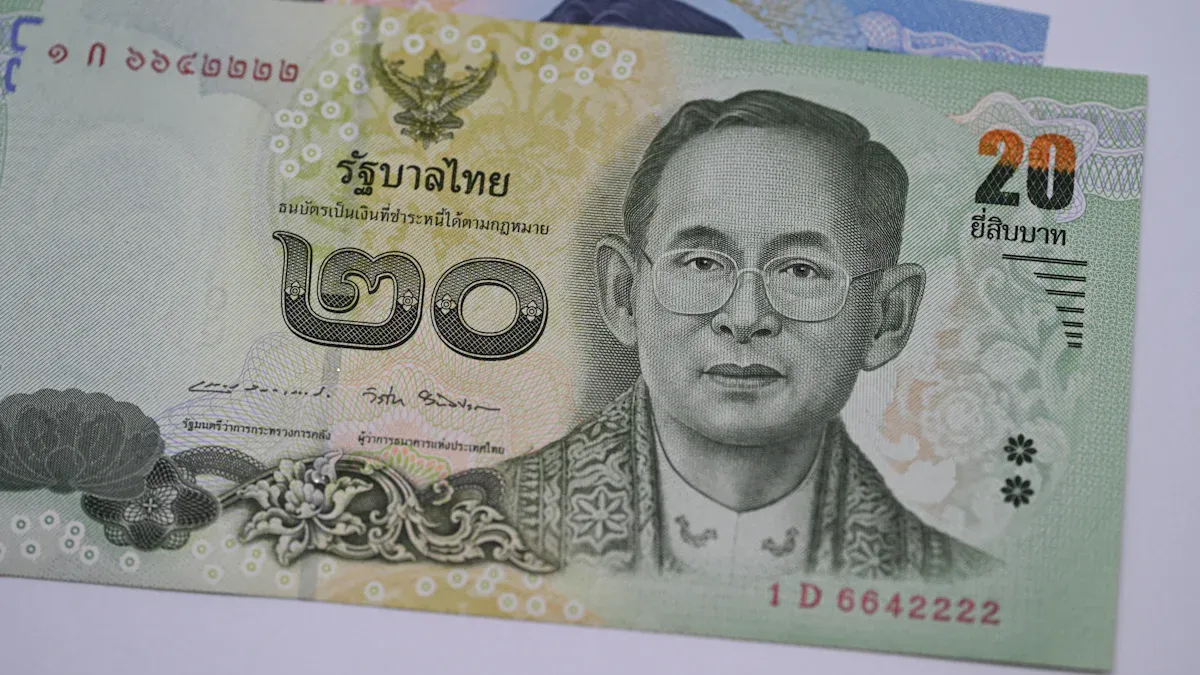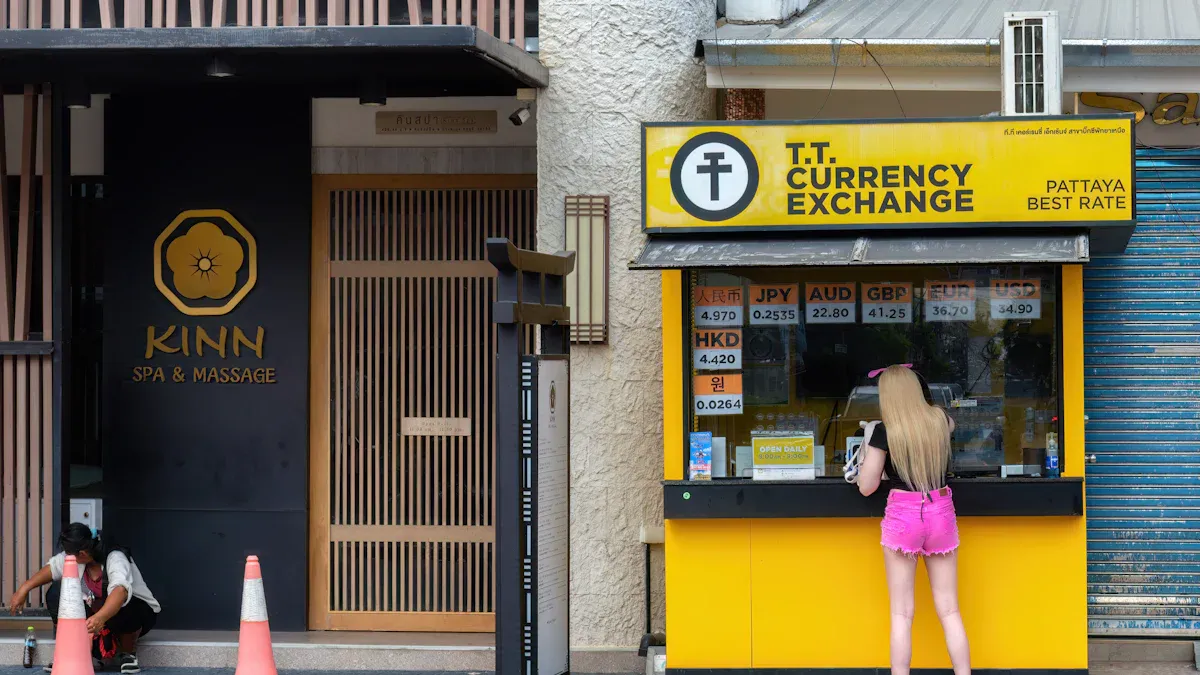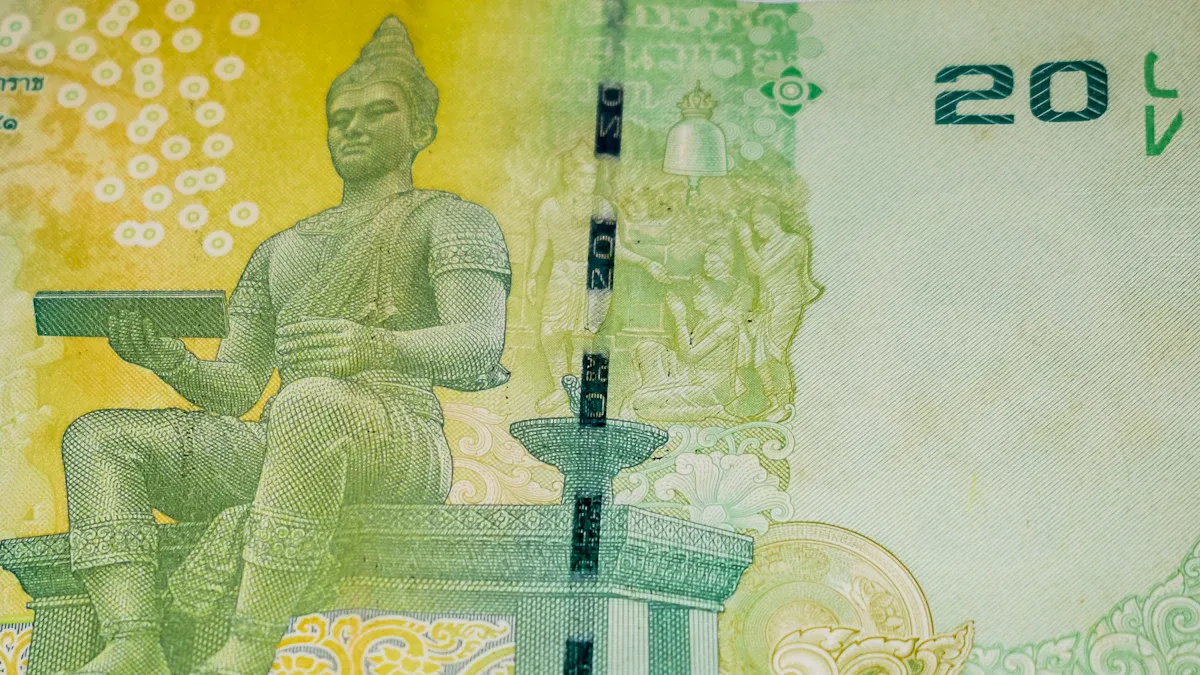- EasyCard
- Trade
- Help
- Announcement
- Academy
- SWIFT Code
- Iban Number
- Referral
- Customer Service
- Blog
- Creator
International Transfers to Thailand: A Complete Guide on Procedure and Fees

Image Source: pexels
You may wonder how to safely transfer money from mainland China to Thailand. Common international remittance channels include bank transfers, e-commerce platforms, and third-party payment tools. Each method has different operational processes and fee standards. You need to consider the pros and cons of each channel and choose the most suitable remittance method based on your actual needs. Before remitting, prepare the recipient’s information and relevant documents to enhance remittance efficiency.
Key Points
- Choose the appropriate remittance channel. Bank transfers are suitable for large amounts, while third-party payment platforms are ideal for small and frequent transfers.
- Prepare required materials in advance. Valid identification and recipient information are key to ensuring a smooth remittance.
- Pay attention to fees and exchange rates. Fee differences across channels can be significant, and choosing a transparent fee structure can save money.
- Understand arrival times. Bank transfers typically take 3-5 business days, while third-party payment platforms may deliver funds on the same day.
- Ensure information accuracy. Carefully verify recipient information to avoid delays due to errors.
International Remittance Methods

Image Source: pexels
Bank Transfers
You can choose to make international remittances through banks. This method is traditional and suitable for scenarios requiring high security. You need to visit a bank branch or use online banking services, submitting identification and recipient information. Banks typically require the recipient’s name, Thai bank name, and account number. Licensed Hong Kong banks support multiple currencies, including USD and THB. Bank transfer processing times generally range from 1 to 5 business days. You can process transfers at a bank branch, through online banking, or via mobile apps. Banks charge a certain fee, usually priced in USD. Bank transfers are suitable for large remittances or business fund transfers.
Tip: While bank transfers are secure, they have higher fees and may take longer to arrive. Prepare all materials in advance to avoid delays due to incomplete information.
Third-Party Payment
You can also choose third-party payment platforms for international remittances. Common platforms include Wise, Paysend, and Alipay International Remittance. These platforms support online operations with simple processes. You only need to register an account, fill in recipient information, and upload identification. Third-party platforms typically support mainstream currencies like USD and THB. Fees are lower, and some platforms offer same-day arrivals. Third-party payments are suitable for small personal remittances or frequent transfers. You can complete remittances anytime, anywhere via mobile or computer without visiting a bank.
E-Commerce Platforms
E-commerce platforms like PayPal also offer international remittance services. You can transfer funds from mainland China to Thailand through a PayPal account. PayPal supports multiple currencies with a relatively simple process. You need to link a bank card or credit card and provide the recipient’s email and related information. PayPal is suitable for cross-border shopping, service payments, or small remittances. Arrival times are generally 1 to 3 business days, with fees priced in USD. You can use PayPal directly for payments and receipts in e-commerce transactions.
Other Channels
In addition to the above methods, you can consider specialized international remittance service providers. For example, Airwallex offers fast account opening and low-fee remittance services for business users. Some channels support same-day arrivals, suitable for businesses or cross-border trade scenarios. You need to choose the appropriate channel based on your needs, considering currency support, account requirements, and fee structures. Different channels vary in process and arrival speed, so it’s advisable to understand relevant policies and service details in advance.
| Channel Type | Supported Currencies | Account Requirements | Applicable Scenarios | Arrival Time |
|---|---|---|---|---|
| Bank Transfer | USD, THB, etc. | Bank Account | Large Amounts, Businesses | 1-5 Business Days |
| Third-Party Payment | USD, THB, etc. | Platform Account | Small Amounts, Personal | As Fast as Same Day |
| E-Commerce Platform | USD, THB, etc. | PayPal Account | E-Commerce, Service Payments | 1-3 Business Days |
| Other Channels | USD, THB, etc. | Business Account | Businesses, Trade | As Fast as Same Day |
You can choose the most suitable international remittance channel based on your actual needs. Different methods have advantages in security, fees, and arrival speed.
Remittance Process
Bank Operations
You can process international remittances to Thailand through licensed Hong Kong banks. Bank channels have high security requirements, making them suitable for large fund transfers. You need to prepare relevant materials in advance to ensure a smooth remittance. Below is the common required information and materials:
| Required Information | Description |
|---|---|
| Remittance Currency and Amount | Currency and amount to be remitted (priced in USD) |
| Recipient Name and Address | Recipient’s name and detailed address |
| Recipient Account Number | Recipient’s bank account number in Thailand |
| Recipient Bank Name, Address, and SWIFT Code | Detailed information of the recipient bank, including SWIFT code |
You need to visit a bank branch or use online banking services. Bank staff will guide you in filling out the remittance application form. You need to enter recipient information, remittance amount, and currency. Banks will require you to present identification documents. Some banks also perform identity verification to ensure the legitimacy of fund sources. You can choose a real-time exchange rate or a fixed rate provided by the bank. Banks charge a certain fee, priced in USD. After completing all steps, the bank will generate a remittance receipt, which you can keep for future reference.
Tip: Ensure recipient information is accurate when filling it out. Errors may lead to delays or returns.
Platform Operations
You can choose third-party payment platforms for international remittances, such as Wise or Alipay International Remittance. Platform operations are simpler, suitable for small personal remittances. You only need to follow these steps to complete the remittance:
- Log in to your Alipay app or Wise account.
- On the homepage, click “More” or “Financial Management” to find “Global Remittance” or “Cross-Border Remittance” services.
- Search for “Remittance” or “Cross-Border Remittance” and select the corresponding service.
- Choose “Fast Receipt” or a similar function and click “I am the Remitter.”
- Select the remittance country and currency (e.g., USD) and enter the remittance amount.
- Compare exchange rates and service fees across platforms to choose the most suitable option.
- Continue filling in recipient information on the platform’s mini-program or website.
- Review all remittance details and send the funds after confirming accuracy.
When using Wise, the maximum remittance amount per transaction is 100,000 RMB. The platform may limit the total remittance amount based on your annual income and paid taxes. Platforms typically require you to upload identification, and in some cases, perform facial recognition. You can complete operations anytime via mobile or computer without visiting a bank.
Note: Carefully verify information when filling it out on the platform to avoid remittance failure due to errors.
Preparation Matters
You need to be well-prepared before making an international remittance. Whether using a bank or third-party platform, the following materials and information are crucial:
- Valid identification (e.g., ID card or passport)
- Mainland China bank account or third-party payment platform account
- Recipient’s name, address, and Thai bank account number
- Recipient bank name, address, and SWIFT code
- Remittance amount and currency (preferably priced in USD)
- Purpose of remittance (required by some channels)
Preparing all materials in advance can significantly improve remittance efficiency. Ensure accuracy when filling out information to avoid delays due to incomplete or incorrect data. You can also check each channel’s fees and exchange rates in advance to choose the most suitable international remittance method.
Reminder: Before remitting, consult bank or platform customer service to confirm all material and process requirements to ensure funds arrive safely and smoothly.
Fees and Arrival

Image Source: pexels
Fees
When choosing an international remittance channel, you should first focus on fees. Fee standards vary significantly across channels. Bank remittances typically charge fixed fees, while third-party payment platforms charge service fees based on the amount and payment method. Refer to the table below for fee details of common banks and third-party platforms:
| Channel | Remittance Type | Minimum Fee (USD) | Maximum Fee (USD) |
|---|---|---|---|
| Licensed Hong Kong Bank | Personal Wire Transfer | 8 | 33 |
| Licensed Hong Kong Bank | Business Wire Transfer | 15 | 33 |
| Bank of China | International Remittance (USD) | 18 | 18 |
| Bank of China | International Remittance (RMB Pre-Settlement) | 18 | 19.5 |
| Alipay | Cooperation with East Asia Bank | 15 | 15 |
| Alipay | International Credit Card Payment | 3% of amount | 3% of amount |
| Wise | Based on Amount and Currency | Transparent Fees | Transparent Fees |
When processing international remittances at a bank branch, you typically pay a fixed fee. Third-party platforms like Wise and Alipay charge fees based on the remittance amount, currency, and payment method. Some platforms adjust fees based on partner bank policies. Check the fee structure in advance to avoid high fees impacting the actual received amount.
Tip: Check the latest fee standards via the official website or customer service before remitting to plan fund transfers reasonably.
Exchange Rates
When making international remittances, exchange rates significantly affect the received amount. Banks and third-party platforms may use different rates, and some platforms add a profit margin to the nominal rate. You need to consider rate differences and hidden costs to maximize the recipient’s actual received amount. The table below summarizes common fee types:
| Fee Type | Description |
|---|---|
| Transfer Fee | Upfront fee charged when initiating a remittance, possibly a fixed amount or percentage. |
| Exchange Rate Margin | Some channels add a profit margin to the exchange rate, reducing the actual received amount. |
| Payment Method Fee | Different payment methods (e.g., bank transfer or credit card) may incur additional fees. |
| Receipt Method Fee | Different receipt methods (e.g., cash pickup or bank deposit) may have varying fees. |
When using platforms like Wise, you can enjoy mid-market exchange rates with transparent fees. Some banks and platforms add a percentage to the rate, resulting in a lower received amount than expected. Compare exchange rates across channels before remitting to choose the best option.
Note: Be cautious of hidden costs, especially exchange rate margins and payment method fees, which can affect the final received amount.
Arrival Time
When remitting, arrival time is a key consideration. Different channels have varying arrival speeds. Bank remittances typically take 3-5 business days, while third-party payment platforms can deliver funds as fast as the same day. Refer to the table below for typical arrival times of each channel:
| Service | Typical Arrival Time |
|---|---|
| Licensed Hong Kong Bank | 3-5 Business Days |
| Wise | 1-5 Business Days |
| Paysend | Seconds to 3 Days |
| Alipay | 1-3 Business Days |
- Wise: You typically receive funds within 1-5 business days.
- Paysend: You can receive funds in seconds, up to three days.
- Bank Channels: You generally wait 3-5 business days.
Arrival times are affected by factors like remittance amount, currency, and recipient bank processing speed. For urgent needs, prioritize platforms with fast arrivals.
Tip: During holidays or peak periods, arrival times may be extended. Plan ahead to avoid fund delays.
Limits
When using different channels for international remittances, you must also consider remittance limits. Banks and third-party platforms have different restrictions on single, daily, or monthly remittance amounts. On the Wise platform, each transaction is capped at 100,000 RMB, and the platform sets annual totals based on your income and tax status. Bank channels are suitable for large remittances, while third-party platforms are better for small and frequent transfers.
- Bank Channels: You can process large remittances, suitable for businesses or fund transfers.
- Wise/Paysend/Alipay: You have a cap per transaction, suitable for personal daily transfers.
- Platforms review limits based on your identity verification and fund source.
Confirm channel limits before remitting to avoid transaction failures due to exceeding limits. You can split remittances or choose a more suitable channel.
Reminder: For large remittances, consult bank or platform customer service in advance to ensure compliance and smooth arrivals.
Regulations and Compliance
Foreign Exchange Regulations
When making international remittances from mainland China, you must comply with China’s foreign exchange management policies. China imposes strict limits on individual annual foreign exchange purchases, with a maximum of 50,000 USD equivalent per person per year. When processing remittances, banks require you to specify the purpose and verify the fund source. Licensed Hong Kong banks also conduct compliance reviews based on Chinese and Thai regulations. You must truthfully declare the remittance amount and purpose, and avoid circumventing regulations through transaction splitting or false declarations. Chinese foreign exchange authorities closely monitor large and frequent cross-border fund flows to ensure legal compliance.
Recipient Requirements
When receiving funds in Thailand, banks require complete and accurate information. You need to ensure the recipient’s name and account number match bank records. The table below summarizes the main information required for receiving funds in Thai banks:
| Required Information | Description |
|---|---|
| Account Holder Name | Must match the name on the passbook |
| Account Number | Must match the number on the passbook |
| Recipient Bank Name | E.g., Bank of China (Thai) |
| Recipient Bank Address | E.g., 179/4 South Sathorn Road, Bangkok City Tower, Bangkok, Thailand |
| SWIFT Code | E.g., BKCHTHBK |
You also need to provide the recipient’s contact phone number, 18-digit Chinese ID number, and remittance amount. Banks verify identity based on this information to ensure secure fund arrivals. Carefully check information when filling it out to avoid remittance failures or delays due to errors.
Risk Prevention
When making international remittances, you must prioritize anti-money laundering and identity verification requirements. Banks and third-party platforms apply different verification measures based on risk levels. For example, during face-to-face transactions, Thai customers must present a national ID, while foreign customers need to verify passport photos. For non-face-to-face transactions, banks require you to upload a selfie and ID or passport scan. High-risk transactions may also require a registration certificate or proof of legal status.
You should pay special attention to compliance risks during large remittances. The table below lists common compliance risk types and descriptions:
| Compliance Risk Type | Description |
|---|---|
| Informal Value Transfer Systems (IVTS) | Bypassing formal banking systems, possibly non-compliant with national currency controls. |
| Circumventing Chinese Currency Controls | Using false declarations or transaction splitting to bypass legal restrictions, which is illegal. |
| Money Laundering Risk | Unclear or unverifiable fund sources trigger intensive bank reviews to prevent money laundering. |
| Transaction Splitting | Splitting large transactions into smaller ones to evade regulation, prohibited in mainland China. |
| Underground Banking | Transferring funds through underground channels, which may be legal in some cases but must ensure legitimate fund sources. |
Before remitting, proactively understand relevant regulations and avoid using informal channels or providing false information. Compliant operations ensure fund safety and facilitate smooth cross-border remittances.
Selection Recommendations
Pros and Cons
When choosing an international remittance method, you need to understand each channel’s features. Different methods suit different people and scenarios. The table below helps you compare quickly:
| Channel Type | Pros | Cons | Applicable People/Scenarios |
|---|---|---|---|
| Bank Transfer | High security, suitable for large remittances | High fees, slow arrivals | Businesses, Fund Transfers |
| Third-Party Payment | Low fees, fast arrivals, convenient | Lower limits, requires real-name verification | Personal, Small, Frequent Transfers |
| E-Commerce Platform | Suitable for e-commerce, service payments, simple process | High exchange rate margins, limited services | Cross-Border Shopping, Service Payments |
| Other Channels | Diverse business services, fast arrivals | High account requirements, some need business qualifications | Businesses, Trade |
You can choose the appropriate channel based on your needs. For large fund transfers, licensed Hong Kong banks are safer. For speed and cost, third-party payment platforms are better for daily use.
Considerations
When choosing a remittance channel, focus on the following aspects:
- Speed vs. Cost Balance: Some channels are fast but expensive, while others are cheaper but slower.
- Fee Structure: Note transfer fees, exchange rate margins, and hidden costs to avoid high transaction fees.
- Compliance: Understand Chinese/mainland China and Thai foreign exchange and banking regulations to ensure legitimate fund sources and purposes.
- Information Accuracy: Verify recipient information carefully to avoid delays or returns due to errors.
- Security: Choose formal channels to prevent fund safety risks.
Tip: Compare multiple platforms before remitting, focusing on real-time exchange rates and service fees to avoid impacts from rate fluctuations or delayed transfers. Don’t overlook compliance requirements, especially for large remittances; consulting bank or platform customer service is safer.
When choosing an international remittance method, consider your needs, focusing on process, fees, and arrival speed. Different channels have their pros and cons. You can:
- Choose reputable services, checking their history and customer reviews.
- Verify recipient information carefully before remitting to ensure accuracy.
- Avoid unsolicited offers and confirm the counterparty’s identity.
Pay attention to compliance issues. KYC and AML requirements are strict, and transactions exceeding 50,000 USD may require additional review. Partnering with professional fintech platforms or licensed Hong Kong banks familiar with Chinese/mainland China regulations can simplify the process. This ensures funds arrive safely and efficiently.
FAQ
How to Choose the Most Suitable International Remittance Channel?
You can choose a channel based on remittance amount, arrival speed, and fees. Banks are suitable for large remittances, while third-party payment platforms are ideal for small and frequent transfers. Understand each channel’s fees and limits in advance.
Tip: Consult bank or platform customer service for the latest policies and service details.
What Materials Are Needed for Remittance?
You need to prepare valid identification, a mainland China bank or third-party payment platform account, recipient’s name, and Thai bank account information. You also need to provide the remittance amount and purpose.
| Required Materials | Description |
|---|---|
| ID Card or Passport | Personal identity verification |
| Bank or Platform Account | Fund source |
| Recipient Information | Bank account details |
What Are Common Reasons for Remittance Failure?
Inaccurate information, exceeding limits, or failing identity verification can cause remittance failures. Carefully verify all materials to ensure completeness.
Reminder: Communicate with the bank or platform in advance to avoid delays due to oversights.
How to Confirm Receipt After Remittance?
You can confirm receipt via bank SMS, platform notifications, or recipient feedback. You can also log into bank or third-party platform accounts to check transaction records.
Are There Amount Limits for Remittance?
Banks and third-party payment platforms have different limits for single and annual remittance amounts. In mainland China, you can remit up to 50,000 USD equivalent per year. Check channel limits in advance to plan fund transfers reasonably.
You’ve completed the full analysis of international money transfers to Thailand, gaining insight into the pros and cons of bank transfers (high security but costly and slow) and third-party payment platforms (low fee, same-day but low limits), along with critical compliance details like SWIFT codes, AML, and KYC. For cross-border payments like tuition or rent, you certainly don’t want to deal with the high fixed fees, non-transparent exchange rate markups, and the lengthy 3–5 business day waiting period typical of conventional channels.
You need a modern financial solution that can bypass traditional barriers, balance security and compliance, and deliver maximum efficiency at a low cost.
BiyaPay is your ideal choice for seamless fund transfers to Thailand. We provide real-time exchange rate inquiry and conversion services for fiat currencies, with remittance fees as low as 0.5% and zero commission on contract limit orders, helping you maximize cost savings. BiyaPay supports most countries and regions globally and offers same-day fund arrival, significantly surpassing the speed of traditional banks. Furthermore, you can use one platform for global asset allocation, including US and Hong Kong stocks, without needing a complex overseas account. Register quickly with BiyaPay now, and leverage transparent fees and superior efficiency to ensure your funds reach Thailand safely, compliantly, and swiftly.
*This article is provided for general information purposes and does not constitute legal, tax or other professional advice from BiyaPay or its subsidiaries and its affiliates, and it is not intended as a substitute for obtaining advice from a financial advisor or any other professional.
We make no representations, warranties or warranties, express or implied, as to the accuracy, completeness or timeliness of the contents of this publication.




Contact Us
Company and Team
BiyaPay Products
Customer Services
is a broker-dealer registered with the U.S. Securities and Exchange Commission (SEC) (No.: 802-127417), member of the Financial Industry Regulatory Authority (FINRA) (CRD: 325027), member of the Securities Investor Protection Corporation (SIPC), and regulated by FINRA and SEC.
registered with the US Financial Crimes Enforcement Network (FinCEN), as a Money Services Business (MSB), registration number: 31000218637349, and regulated by FinCEN.
registered as Financial Service Provider (FSP number: FSP1007221) in New Zealand, and is a member of the Financial Dispute Resolution Scheme, a New Zealand independent dispute resolution service provider.



















